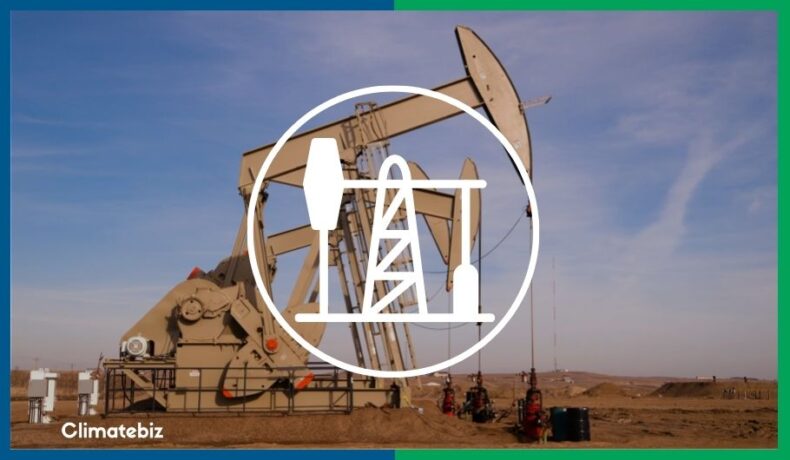“Why is fracking controversial? I mean, it helps us so much with sourcing natural gas and oil!”
Sure, but the process of fracking is highly controversial at the moment due to the threat it poses to our environment. The process does have its advantages – it can provide us with gas security for over 100 years and it’ll release 50% less CO2 emissions than coal.
According to the IPAA, fracking has produced more than 7 billion barrels of oil in the U.S.
However, the process uses a huge amount of water and can release these gasses into underground water supplies.
Do the advantages balance out the environmental threat fracking poses? Is there a way to use fracking safely? Should drilling companies be fracking at all?
Let’s take a look.
Table of Contents
What Is Fracking?
Under our feet, there are multiple layers of rock that contain precious resources. Some of these resources are natural oil and gas. In a layer of rock called shale, gas and oil have been trapped in small cracks.
Fracking, also known as Hydraulic Fracturing, is when drill companies extract the oil and gas from these fissures.
First, a well is drilled vertically, deep into the sedimentary rock layer. Then, the drill is turned and tunnels are dug horizontally through the earth. A water well casing is then installed and a high-pressure liquid called slickwater is injected into the well.
Slick water enters the fissures, forcing them open. This releases the oil and gas, which the well then extracts.
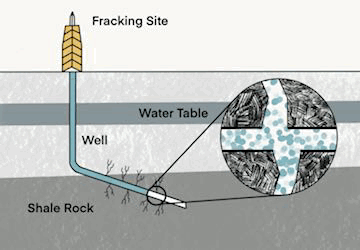
Source: Climatebiz
Fracking wells can be between 1 and 2 miles deep and use between 0.8 – 5 million gallons of water per well.
Digging the wells doesn’t only require natural resources, but labor resources too. In the United States, fracking started in 1974 and has since provided 2.7 million jobs for middle-skill workers.
As a result, fracking has extracted more than 7 billion barrels of oil in America alone. In addition, it’s captured 600 trillion cubic feet of natural gas.
Fracking seems like a good practice with a great yield, so why is fracking controversial?
Why Is Fracking Controversial?
The controversy begins with the fact that there are studies backing both sides of the debate.
Does fracking pose a threat to our environment?
Pro-fracking
There are many studies that support fracking, dismissing environmental damage as malpractice.
The following points are used to support fracking:
- Less Co2 Emissions
- Boosts the Economy
- Energy Security
Fracking Produces Less CO2 Emissions Than Coal
According to the U.S. Energy Information Association (EIA), burning natural gas produces 50%-60% less CO2 than coal does.
Therefore, on paper, fracking produces less CO2 emissions than coal. It allows more people to access natural gasses instead of using coal boilers. Industries that use natural causes will also have a lower CO2 footprint.
However, not all industries use efficient gas burners, releasing more emissions than they should. In addition, this doesn’t factor in the amount of CO2 released during the process of fracking.
Transporting the water to the fracking wells and collecting the gas and oil produces CO2 as a by-product.
The Effects Of Fracking Boosts The Economy
Straight off the bat, fracking offers a lot of job opportunities to the average American. 2.7 million jobs have been created for middle-skill workers.
According to The Washington Post, the American economy has grown 7.6% since 2009. However, gas and oil production only contributes 0.6 percentage points.

Source: EIA
Fracking has also brought down the price of gas according to the EIA. To support this, The Washing Post highlights a study from Boston Consulting Group. The study suggests that the natural gas from fracking saves the average household $425 to $725 a year.
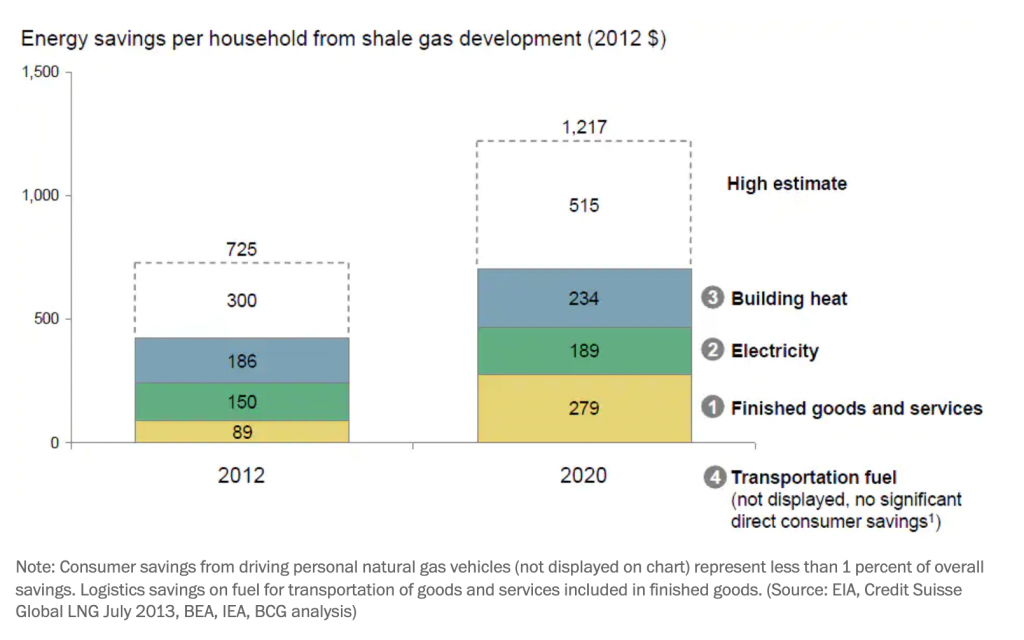
Source: EIA, Credit Suisse Global LNG July 2013, BEA, IEA, BCG analysis
Fracking provides Energy Security
The U.S. currently imports 40% of its oil. Due to fracking and other oil mining advances, this rate should drop to 32% in the coming years.
This means that the U.S. can depend less on other counties for oil and more on themselves.
But how much oil and gas does the U.S. have under its soil?
According to the EIA, America’s crude oil reserve is at 29 billion barrels of oil. While its natural gas reserve has 348.8 trillion cubic feet available.
Fracking would allow America to access these resources and sustain itself for 13 years without importing gas or oil.
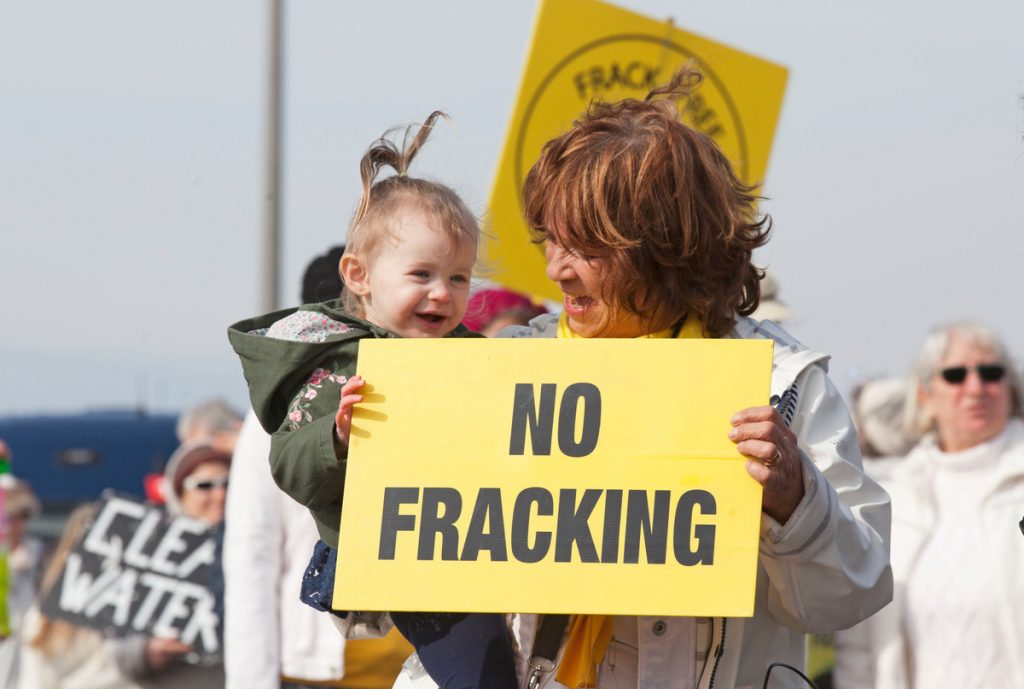
Source: Greenpeace.org
Anti-Fracking
There are always two sides to every coin. The fracking coin is no different.
There are 3 main points that are against fracking:
- Water Usage
- Water Pollution
- Air Pollution
Water Usage
The fracking process uses a huge amount of freshwater. This study shows that the most intensive drills use 8 million gallons of water. That’s roughly 12 Olympic swimming pools of water.
However, the smaller wells use around 418 thousand gallons of water, which is less than other industries.
When compared to the total freshwater consumption of the United States, fracking only contributes to 0.3% of that amount.
However, this is a national comparison and the consumption changes from state to state. According to the New York Times, 25% of freshwater consumption goes to fracking. This has an effect on local farmers and communities who are seeing their wells dry up.
Water Pollution
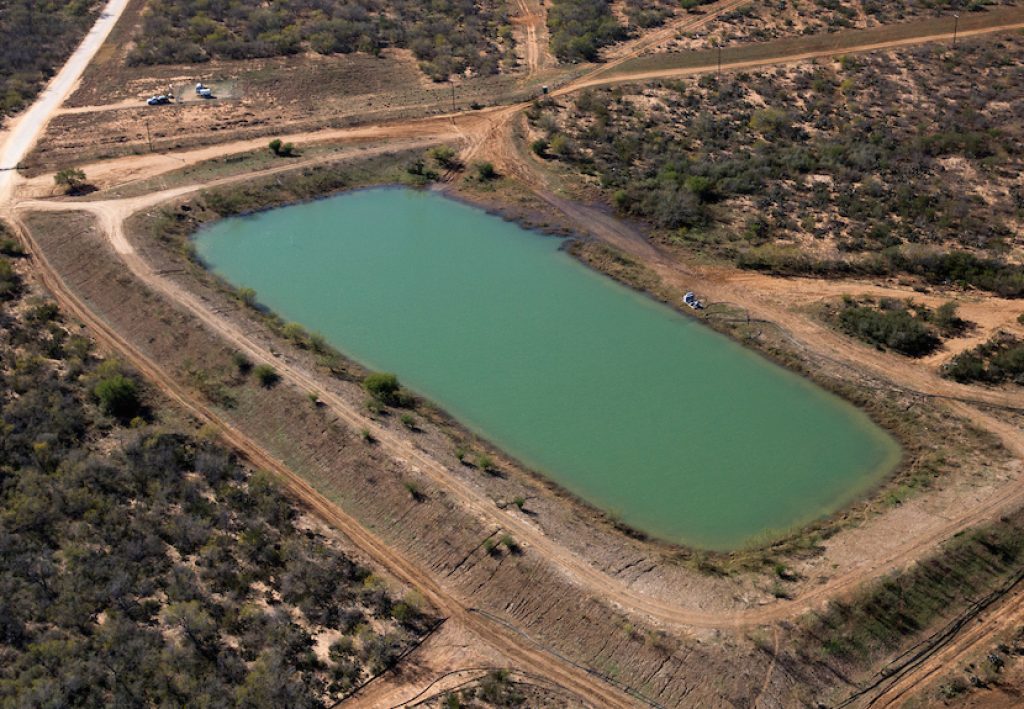
Source: sierraclub
We’ve just covered the amount of what fracking uses, but where does the water go once it’s been used?
Since the water used for fracking contains sand and chemicals, disposing of the water into rivers and lakes is illegal. Drilling companies need to find other ways to dispose of the water.
Often, they store the water in large tanks before treating it, or simply direct it into a basin. There, the water is left to evaporate, leaving the soil and chemicals behind.
But waiting for 12 swimming pools of water to evaporate takes a long time. Often the polluted water seeps into the ground and contaminates the environment around the basins.
However, many companies have environmentally-safe ways of treating and disposing of the water.
The other issue is that in some cases, the gas leaks and contaminates underground water reservoirs.
It’s important to note that this rarely happens and gas leakages are due to bad practices from drilling companies.
Air Pollution
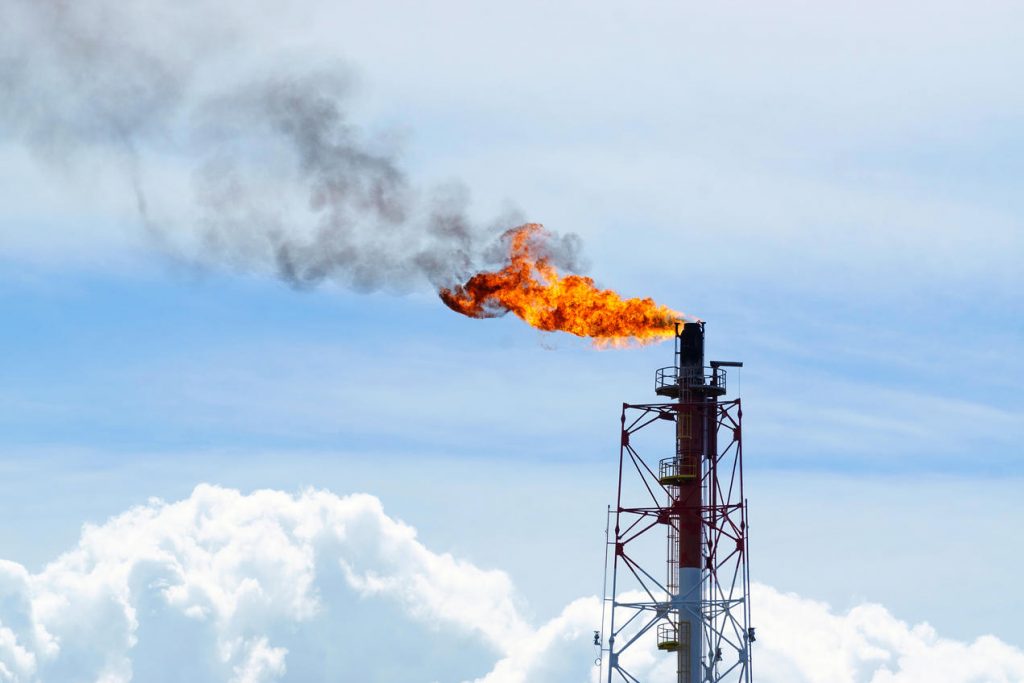
Source: NRDC
Whilst fracking may lead to lower levels of CO2, one of the main gasses released through fracking is methane.
Methane is a potent greenhouse gas that’s 25% more effective at trapping heat in the atmosphere than CO2.
Many parts of the fracking process include burning off some of this methane. This process is also known as flaring.
Fracking also releases other gases and compounds into the atmosphere. These chemicals can cause central nervous system and respiratory problems. Among these are:
- Benzene
- Toluene
- Ethylbenzene
- Xylene
Why Choose Fracking At All?
As explained above, there are many opinions and facts about fracking. However, another reason why fracking is controversial is why use fracking at all?
Why are governments investing in fracking when they could be investing in green alternative energy?
Proving that natural gas produces 50% fewer carbon emissions does not hold up against alternative energy that’s carbon zero.
Alternative energy devices such as solar panels or wind turbines offer a much greener and more sustainable future.
Why invest in a resource that can deplete in 13 years when alternative energy sources are unlimited?
How Does Fracking Work?
So we know that fracking includes drilling a hole and capturing the gas and oil. But how exactly does it work?
First, the well is dug out – vertically at first and then horizontally. The well casing is then built to ensure that the hole does not collapse on itself.
Then, once the hole is dug, small charges are lowered to the bottom of the well and set off. This isn’t to break the earth but rather to punch holes in the well casing.
The third step is the injection of water into the well at high pressures. Except, it’s not ordinary water. The liquid they use is called slick water and consists of water, sand, and a mix of chemicals.
The water breaks open the existing cracks in the shale rock, creating fissures. The sand is what keeps the fissures open and the chemicals prevent rust and the deterioration of the well casing.
After the water has opened the cracks, it’s removed from the well and disposed of.
The final step consists of gas flowing up and out of the well and then being captured in large gas storage tanks. From there, it’s transported to consumers through pipelines.
Which Countries Frack The Most?

Source: EIA
Many countries around the world have basins of natural gas available to them. However, some of them don’t have the resources, like water, available.
In some countries, fracking is completely banned or just not a feasible option as an energy source.
However, there are only 4 countries in the world that frack efficiently enough to produce shale gas/oil commercially. Despite the controversial topic of fracking, these countries have gone ahead and turned fracking into a massive industry.
Those countries are:
- The United States of America
- Canada
- China
- Argentina
How Can Fracking Be Reduced Or Stopped?
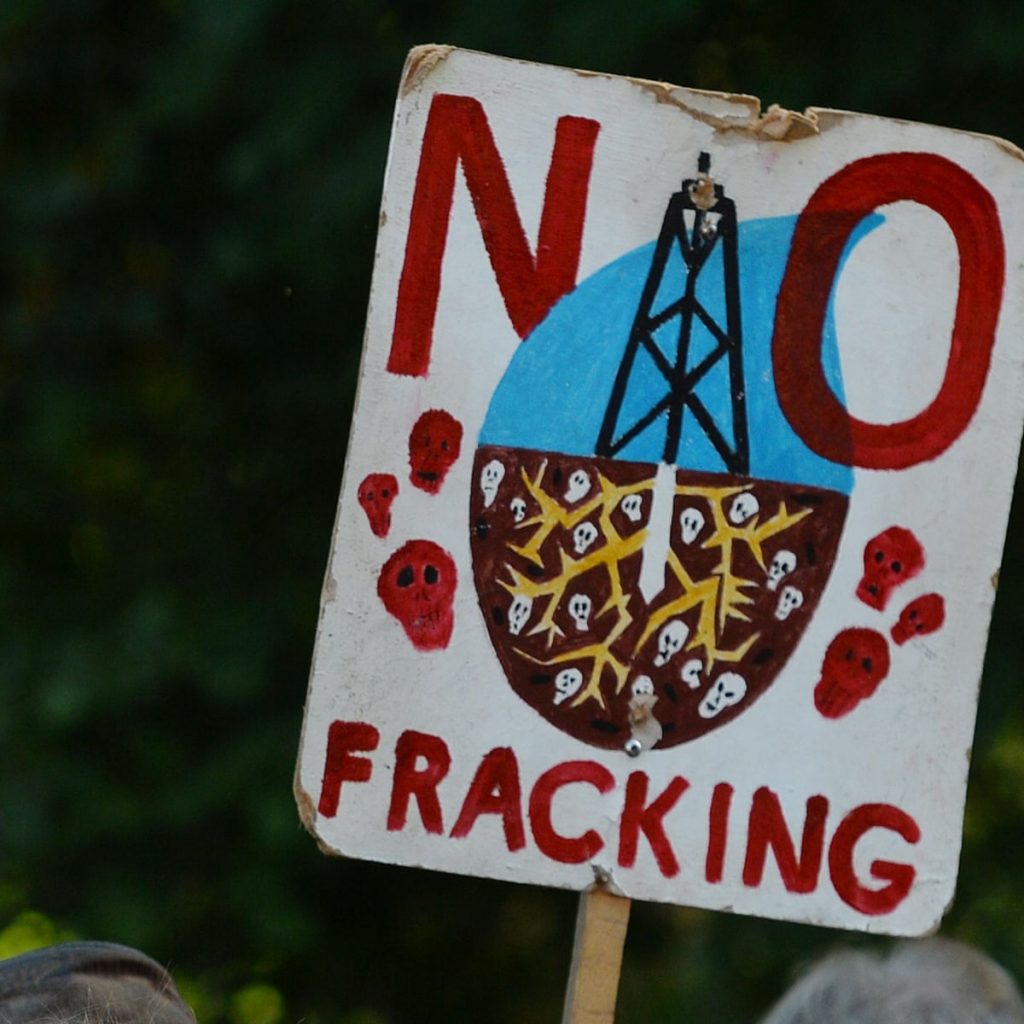
Source: the guardian
If we’ve convinced you that fracking is not the solution to dwindling fossil fuels, there are a few things you can do.
How Can You Stop Fracking?
The best way to stop or reduce fracking in your area is through your local government. Speak to a representative or sign a petition to stop fracking in your state.
It can sometimes feel helpless when going up against major organizations, but small changes add up.
There are tons of protests around the globe against fracking in an attempt to ban fracking altogether. There are multiple groups like Greenpeace that fight against fracking which you can support.
Are There Ways To Make Fracking More Environmentally Friendly?
There are a few practices and methods that can be adopted to make fracking greener.
Turning fracking into a greener practice can make the process less controversial and lower its impact on the environment.
Here are a few things that can be changed:
- Use fracking systems that don’t require water. Using a waterless system means that fracking won’t waste all that fresh water. Instead, systems can use condensed CO2 or propane to pressurise the system.
- Use greywater instead. An alternative to water-less systems is using greywater instead of clean water. Greywater is recycled water from showers, sinks, washing machines and baths. Basically any water that’s been used but doesn’t contain urine or faeces. The greywater can be collected from nearby communities and transported to the fracking site.
- Replace diesel powered equipment. Replacing the diesel equipment used on site will reduce the amount of CO2 emissions. Instead, equipment that uses natural gas or solar panels should be used.
- Reduce methane leaks. As simple as this may sound, reducing the amount of methane leaks will make the whole system greener. By installing infrared cameras, you’d be able to detect leaks with ease. Another option is to replace the pressure-monitoring controllers with newer designs.
Final Thoughts
Fracking is so controversial because there are many opinions and studies about it. No matter where you look, you’ll find scientific data to support each side of the coin.
However, there are some drawbacks to fracking that you can’t just ignore.
Fracking uses an immense amount of fresh water and turns it into polluted water that needs to be treated. In addition to that, the process also releases methane gas and other harmful compounds.
Why invest in fracking when you could invest in alternative energy that’s carbon neutral?
Whatever your opinion may be, we hope we’ve shed some light on why fracking is so controversial.

